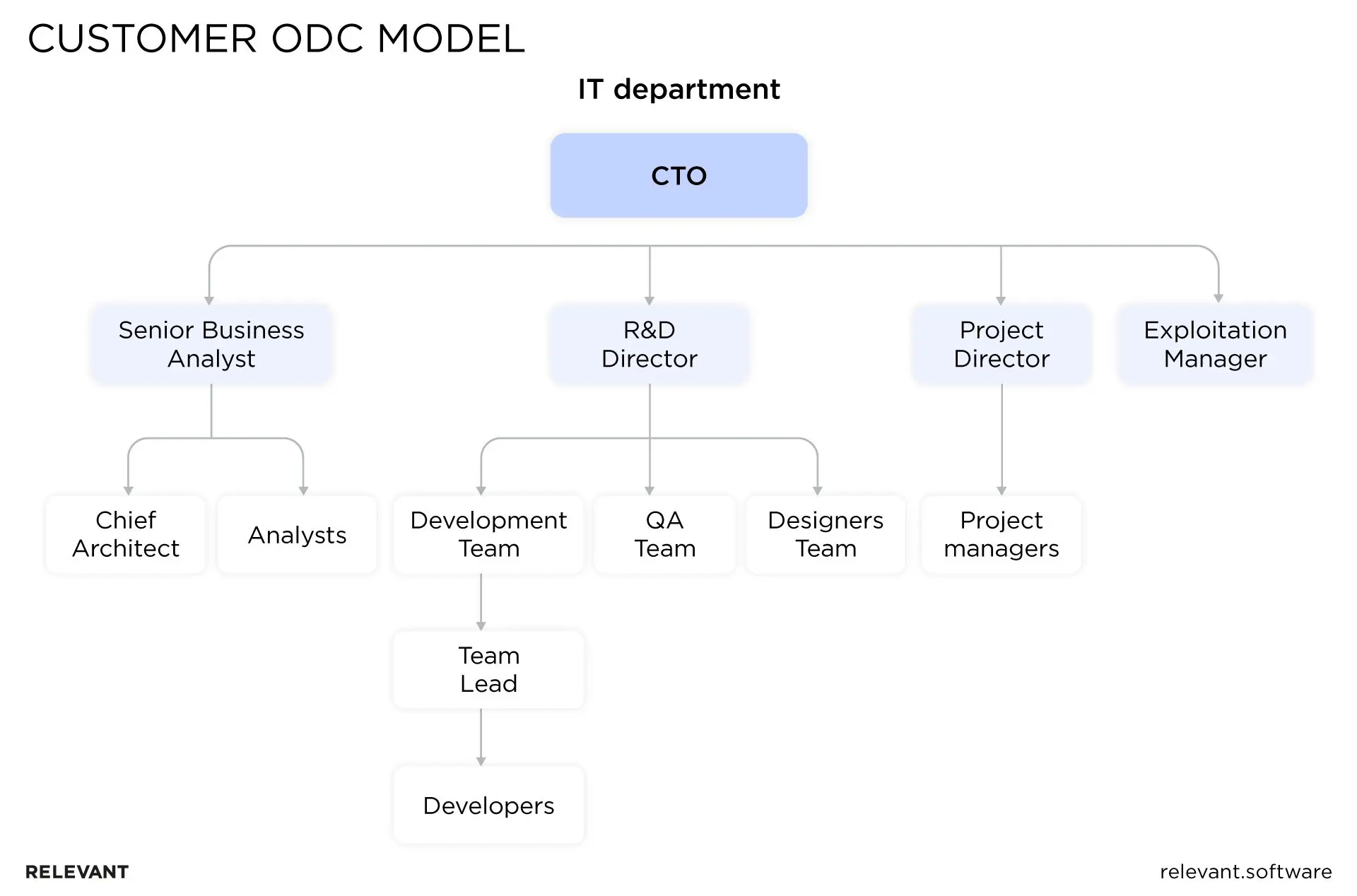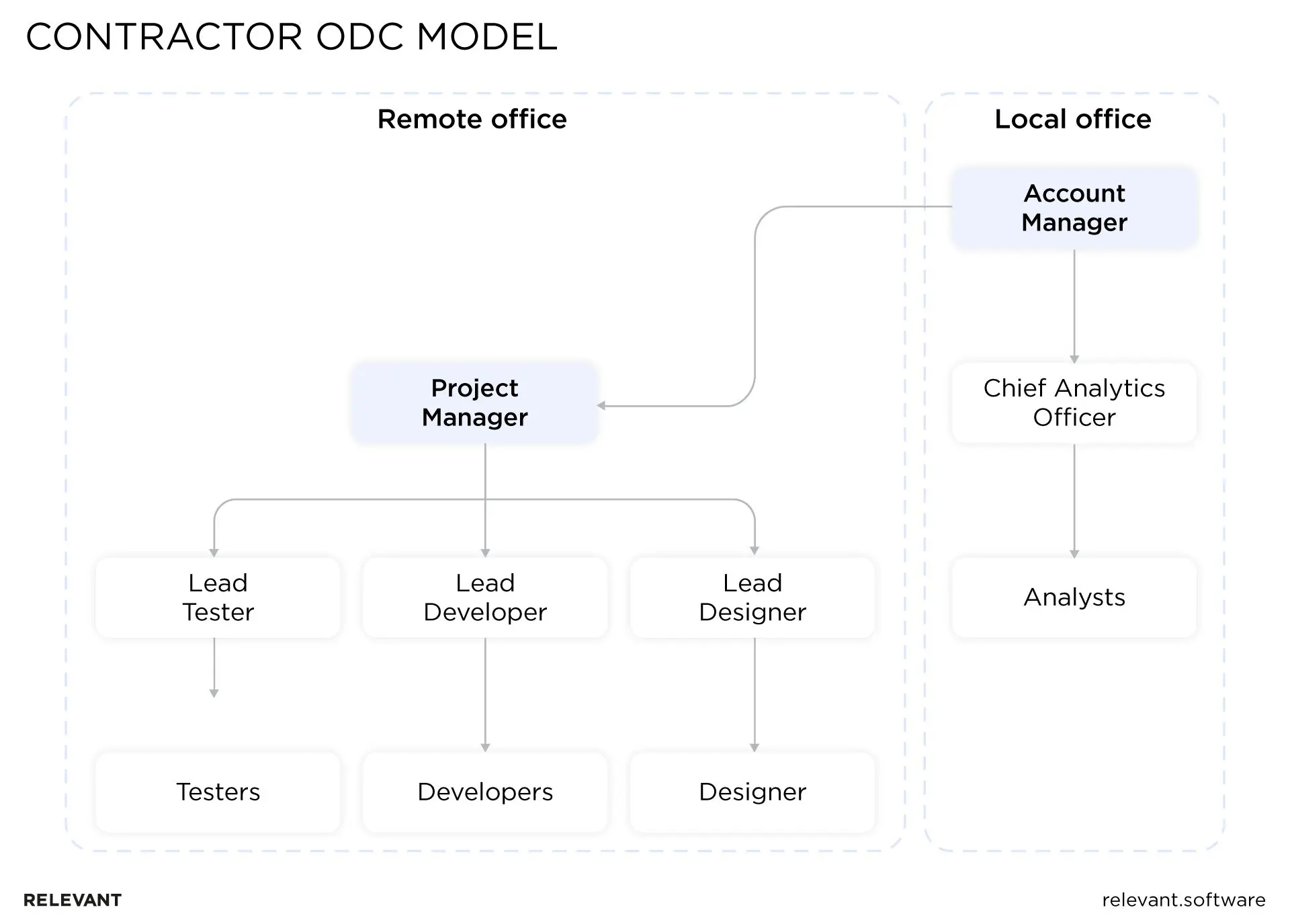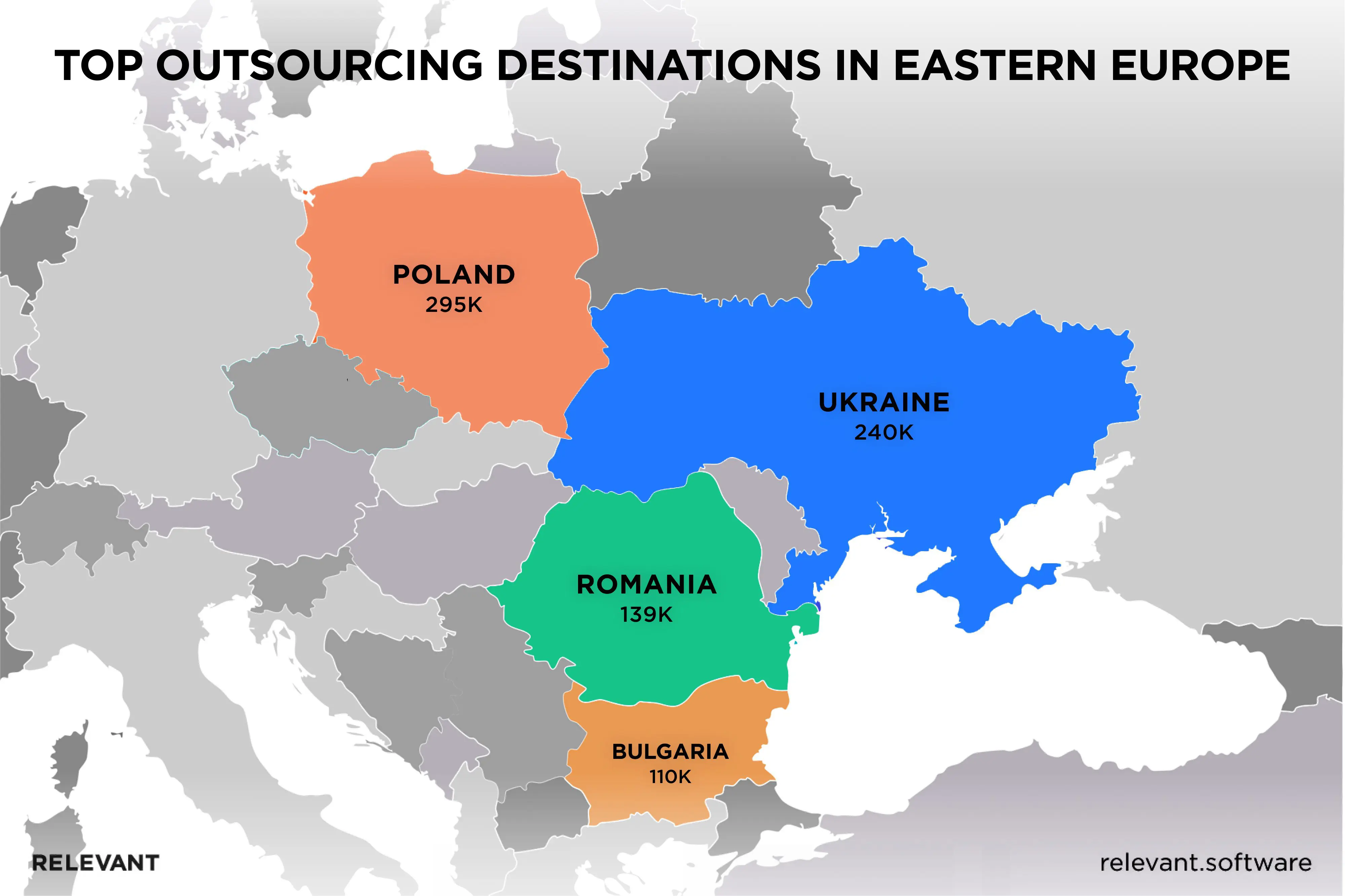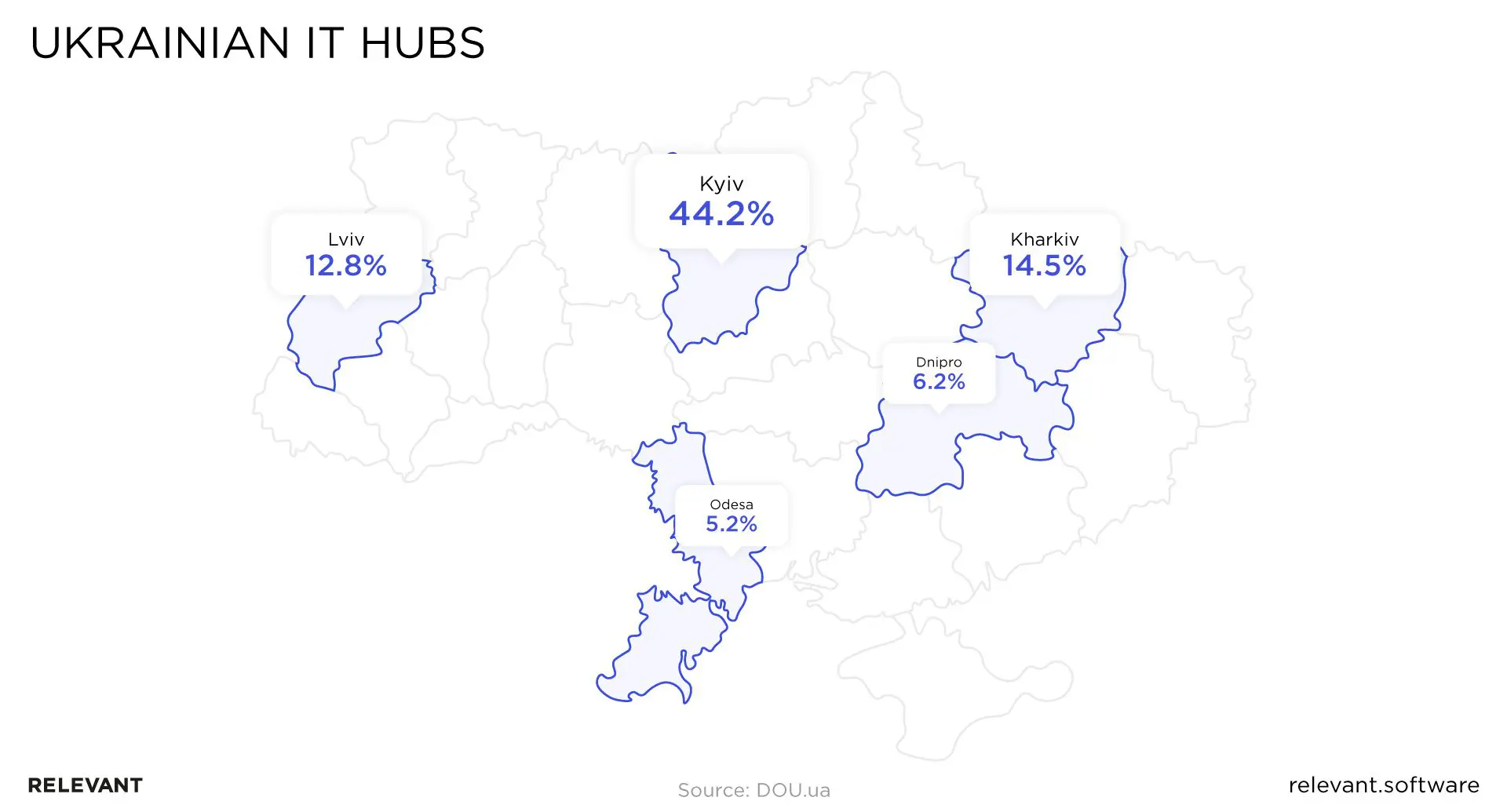How to Set Up an Offshore Development Center in Eastern Europe in 2023

The high cost of hiring and the lack of available experts in the US and EU are forcing businesses to move technology production to other, more cost-efficient locations. Good reasons, such as reduced wages due to a lower cost of living, simplified taxation for IT companies, and access to a huge pool of skilled talents, tip the scales in favor of doing so.
But when it comes to choosing between “offshore development center” and “outsourced software development,” executives can get into difficulties. How to draw a line between them?
As Relevant has mastered various software project delivery approaches, we can explain the differences between offshore development centers (ODC) and outsourcing, the benefits of building offshore development centers, the possible destinations, and why you should choose Eastern Europe to set up ODC in 2023.
What is an Offshore Development Center?
Whether you’re a startup looking to hire software engineers to build your product, a company searching for ways to improve your core platform to support further growth, or even a global enterprise that needs innovative software to strengthen your market position, look closely at ODC. This business model allows you to outsource software development and other IT-related work to overseas locations. It entails the creation of a foreign dedicated development team to work on projects requiring the collaboration of over 30 people.

You may think of an ODC as the company’s technical representation. That means it operates under the same brand and shares the parent company’s corporate policies, providing scalable technological resources that exclude excess expenses. Employees in an offshore development center primarily operate as an in-house team, delivering value to the company and pursuing its core business goals. The parent company directly monitors the services of the offshore development center, interacting with the team members responsible for execution directly or through the project manager.
What is the Difference Between Building an ODC and Outsourcing?
As mentioned, an offshore development center model often needs to be clarified with IT outsourcing services. These are two popular approaches used or even combined by tech companies when moving overseas. Although the two terms overlap to some extent, they do have differences – let’s break them down!
IT outsourcing refers to hiring external expertise to speed up software development and deployment, cut costs, or scale up faster. However, these experts stick around for the project duration only and remain the employees of the technology service provider. The responsibility for the timely completion and project results also rests with the supplier. After the project is over, these talents transfer to their employer’s next project. All this makes IT outsourcing a perfect choice for one-time, short-term projects, whether a landing page redesign or an MVP development.
On the other hand, the offshore development center becomes part of your company. All you need is the help of a local technology partner to put together a team. The talents you hire act like your employees and are more engaged than temporary workers. All the project outcomes are your team’s responsibility. When the project is finished, you handle relocating or firing the staff.
When to Consider Setting Up An Offshore Development Center for Your Business?
Generally, there are three notable cases when outsourcing doesn’t cut it, and you must set up your own overseas development facility with a cross-functional team.
Your project is big and complex
There’s a vast difference in the scope of work between developing a mobile dating app and building a corporate ERP platform for a global supply chain. Assessing project requirements helps define the intended range of work and time & cost estimates. If the development takes over a year and the product requires ongoing support and improvements, ODC is your way.
You require a big team with diverse tech expertise
You usually only need a backbone team to develop a mobile app, but delivering an enterprise solution requires more than a dozen people. And if creating it means you’ll be working with machine learning, analyzing big data, and operating mission-critical information, you will also need rare experts like data scientists, cybersecurity, and machine learning pros. When your project requires more than 40 specialists, ODC becomes preferable to outsourcing.
Your business has security-sensitive software
If your product handles security-sensitive data (mission-critical business information, partner’s financial data, customer’s details, or any information where disclosure can result in devastating reputational, financial, and political consequences), secure storage and management of such data become a top priority.
Engaging an internal cybersecurity team or forming a long-term partnership with a reliable vendor is essential, and the ODC model suits this approach best. (Learn more about how to hire a site reliability engineer and cybersecurity expert.)
Benefits of ODС You Should Know
Why are large corporations and SMEs turning to offshore development centers? What can your company gain by creating it? Let’s dive deeper into the advantages of the dedicated offshore development center. These are:
- Tapping into a massive talent pool. A specialized ODC gives you a talent pool of competent people based on your company’s needs. Since you will have total control over the specialists assigned to the projects, you may be confident in the quality of their work.
- Cost-effectiveness. From smaller back-office payments to lower developer salaries and IT infrastructure expenses, ODCs allow saving a ton on CapEx and OpEx. You can rent an office space and pay all the upkeep and utility bills — or let the technology partner establish your ODC in their office, greatly reducing expenses on bills, furniture, equipment, etc.
- Increased software delivery speed. When your technology partner builds an ODC for your project, they provide tried and tested processes, toolchains, and software project management best practices. This ensures lower managerial and operational overhead, leading to faster software delivery cycles. Besides, being in different time zones means your daily tasks are often done overnight, further speeding up the software development process.
- Mitigating security risks. In some cases, opening such a center may be a measure to improve the security of the development since ODCs operate under a non-disclosure agreement and comprehensive technical security measures.
Top Challenges When Starting Offshore Software Development Center
You may face some difficulties when setting up an offshore software development center. It’s crucial to carefully evaluate and manage these risks to ensure the project’s success. Among them:
- Challenges with remotely registering a Legal Entity. If you are setting up a branch of your organization in another country, of course, you should study the legal environment and determine if the business policy is favorable for your business. You can hire a vendor to handle the project to avoid dealing with this.
- Cultural distinctions. Differences in cultural values and business models when working with foreigners will always be evident, no matter how well the client organization’s system is replicated in an offshore development center. Therefore, it is necessary to build an integrative system that preserves the essence of the project, but at the same time adapts to the peculiarities of doing business in a given place.
- Organizational structure challenges. Companies have different organizational structures. Unfortunately, what works in your home country may not work where you establish your ODC. That can affect everything from workers’ productivity to the security of your data, the control over operations, and even the quality of services being provided.
- Privacy and security risks. It is important to conduct a security risk assessment in advance and take steps to address the specific pitfalls your offshore development center may face. You will have to build network security into the infrastructure of the offshore software development center.
How Does the Offshore Development Center Model Work?
There are two distinct approaches to running an ODC that differ by the degree of involvement your headquarters have in running the branch office.
The customer model
With this approach, your ODC team is your direct subordinates, so your in-house team is much more involved in their operations and has to interact with them more frequently. This is the best solution for enterprises with sufficient in-house resources to provide complete and timely input needed for ODC to operate efficiently.

The contractor model
With this approach, your in-house account manager communicates with the ODC project manager, who oversees all tasks performed offshore and reports to headquarters. Thus, you concentrate on growing your business while your remote team does all the work needed to build a product. It is a perfect model for startups and small to medium companies that need more in-house resources and end-to-end results from their offshore development center team.

Outsourcing as an Alternative to ODC
But, despite all the advantages, the idea of ODC has a specific scope and does not always meet all the requirements. However, the in-house option doesn’t provide such benefits as reduced operating costs and opportunities for finding unique solutions.
Then the closest alternative should be considered, namely software development outsourcing. It is chosen by enterprises that can entrust their projects or individual tasks to third-party specialists without creating full-fledged IT departments.
Although there are many possible cooperation models, we will discuss the three most common ones. They vary based on the project’s scope: fixed-price contract, time and material pricing, and dedicated development team
Fixed-price contracts
Fixed-time contracts are an excellent choice for launching a product or building an MVP for a startup without a tech team. A technology partner gathers your requirements, provides project estimates, and signs a contract to design, develop, and deliver the required software. But mind that the project scope cannot be adjusted easily, and an additional agreement should be formed for every case. However, this is the best choice for limited-budget projects.
Time and material pricing
T&M can be a good option for projects where the scope of work is not precise. The owner pays for the work and materials by negotiating an hourly rate. This model uses a much more granular approach to project management, including close tracking and a detailed breakdown of costs on the invoice.
Every time the contractor bills the owner, they must show exactly how many hours were spent and what work was done. This model is preferred for long-term projects with dynamic requirements because it provides flexibility as volume or workloads change.
Dedicated development team
Hiring a dedicated development team is the best solution for projects with tight deadlines, startups that need to scale fast, or enterprises that need instant access to specific expertise. This is one of the most popular project engagement models, where you pay to quickly scale your expertise by hiring ready teams from the service provider. Due to fluid workflows, staffing can happen in under a week, and you get an external development team under your control while avoiding administrative hassle.
The dedicated team model can be a middle ground between IT staff augmentation and an offshore software hub. It will help you deal with a lack of talent and skills but with fewer resources than a full-scale offshore development department.
What Location to Choose for Your Offshore Software Development Center?
Companies from the US, UK, Canada, Europe, and Australia have always strived to find cost-effective destinations for outsourcing their IT needs. In previous years, creating an offshore development center in India was considered quite a reasonable decision because the Indians were distinguished by their knowledge of English, were versed in mathematics, and worked for lower wages compared to the US or the EU. Billions have been invested in the Indian economy, making India the third largest startup community in the world, with over five million software developers.
However, the low quality of the Indian code has long since become a byword. No doubt, there are some IT outsourcing companies in India with decades of experience under their belt, yet most Indian developers trade quality for speed quite often. Due to cheap price tags, customers were willing to agree with it and iron out the mistakes later.
But nowadays, the value of the rupee is increasing due to a steady influx of foreign investments. And Indian services have become increasingly expensive. Still, the quality of IT services has not improved, making the customers wonder if there’s an alternative.
Eastern Europe vs. India: where to set up your ODC?
There is, indeed! Eastern European countries — Poland, Bulgaria, Romania, and Ukraine— have risen in prominence as reliable and affordable IT outsourcing destinations. Aside from costs, the benefits of outsourcing to Eastern Europe include the following:
- Cultural fit. Unlike Indian teams who celebrate multiple state and religious holidays, technology providers from Eastern Europe share the same cultural background with their Western customers, so their days off and holidays usually coincide.
- High technical literacy level. The total number of technical institutes and universities in Eastern Europe by far surpasses the number of their Indian counterparts. This provides a steady influx of talented developers that quickly rise in seniority, master new technologies, and obtain new skills more efficiently. This is proven by various coding tournaments, challenges, hackathons, GitHub, and Hacker’s World ratings, where software engineers and teams from Eastern Europe often achieve high positions.
- Growing recognition. As more and more global corporations discover the advantages of outsourcing to Eastern Europe over India, they start opening their R&D centers there. This helps further promote the region as a reliable IT outsourcing hub, recognized by Gartner’s Magic Quadrant, Bloomberg Innovation Index, and other reputable sources.
- Time zone overlap. Eastern European countries fully or partially overlap with Western European and American businesses. This considerably speeds up the software delivery pace.
Popular Offshoring Locations in Eastern Europe to Go For
Let’s take a closer look at some popular IT offshoring destinations in Eastern Europe.

Poland
Poland is home to over 400,000 software engineers working in seven major IT hubs: Krakow, Warsaw, Wroclaw, Poznan, Lodz, Katowice, and Tri-city (Sopot, Gdansk, Gdynia). Polish developers regularly win awards and retain high positions in international developer rankings. They specialize in Java, Python, JavaScript, .NET, PHP development, DevOps, QA services, and iOS and Android mobile app development. The salaries vary from $60 to $90 per hour, depending on the technology, seniority level, and geographical location.
Bulgaria
The IT sector is booming in Bulgaria, showing 15% growth annually. The country is home to over 2,325 IT companies, 70% exporting their services through outstaffing and outsourcing. In 2022, the Bulgarian IT market was valued at approximately $832 million. The country currently has the 5th largest IT economy sector in the EU, and it is estimated to grow 4-5% year on year (YoY) due to steady support from the government.
There are more than 100 000 software developers in Bulgaria, and the demand surpasses the supply two or three times, so all talented STEM (Science, Technology, Mathematics) students get employed instantly. An average hourly wage of an IT engineer in Bulgaria ranges from $38-80, based on seniority level, technology stack, and location.
Romania
Romania is the 6th country in the world regarding the number of certified IT specialists, ahead of the UK, Canada, and Germany. Global corporations like Oracle and IBM established their customer support and R&D centers in Romania, a multicultural and multilingual country with nearly 80% of IT specialists fluent in English and other European languages.
There are 110,000 IT professionals in Romania, and about 9 000 technical university graduates join the workforce yearly. The average IT engineer’s salary in Romania ranges from $40-85, depending on their technology stack (Java, C++, SQL, Python, PHP, JavaScript, etc.) and seniority level. Due to the attractive taxation model, the Romanian IT sector grows at a steady 15% YoY.
Ukraine
Ukraine is regularly named the number one outsourcing destination in CEE, with the biggest pool of certified senior-level IT engineers. The country is also often featured by Gartner, Colliers, and Kearney as one of the top locations for offshoring and IT outsourcing.
Every IT hub in Ukraine has an active IT cluster hosting various conferences, seminars, hackathons, and other events. Several of the largest IT conferences in CEE take place in Ukraine — Lviv IT Arena, Agile Conference, PyCON, and more. Nearly 240,000 IT engineers work in the developer community in Ukraine, many of whom are among the world’s best.

Ukraine has over 100 R&D centers for Microsoft, Oracle, Samsung, Huawei, Boeing, Sony, Ring, and other Fortune 500 global corporations. Some of the world’s most known startups are from Ukraine: Grammarly, PetCube, Gitlab, YouTeam, and TemplateMonster are only some of Ukraine’s notable startups.

Ukraine’s time zone (GMT+2) conveniently overlaps with working hours in most of the EU and borders those in the US, so many tasks can be done on the same day or overnight. The average software developer’s salary in Ukraine ranges from $35-76, depending on seniority, technology stack, and location.
As you can see, Ukraine really is a great destination to set up an offshore development center. But if you decide to outsource instead of building an ODC, Ukrainian technology partners can help you with those tasks too!
Steps To Build An Offshore Software Development Center
Setting up an offshore development center in Eastern Europe has a lot in store for fast-growing companies. However, you should go a long way to create a development center overseas, especially if you decide to go alone without the help of a third-party vendor.
- Choose your ODC destination. You first need to decide on the optimal location of your offshore development center. Many factors exist — from the tax policy to English language proficiency.
- Find a local legislation professional to cover various administrative issues. A consultant is needed to help you look into the lawfulness of a business entity and select the right legal structure.
- Register your company. Once you’ve decided on a legal form, you must submit a package of documents to the territorial registration authority for state registration.
- Find a suitable office. After all the paperwork, you must find a workspace for your offshore unit. The office will need new equipment and other stuff.
- Hire a head accountant with expertise in local taxation to learn more about your tax liabilities.
- Hire administrative staff, recruiters, HR, and the marketing team. As a full-fledged office, your center requires trained personnel to manage the workspace and handle your business processes.
- Launch a promo campaign to market your brand as a great employer. Your new branch needs some exposure to establish its market presence and get a headstart in the unknown business landscape.
- Start hiring developers. And now, if you’re persistent enough to complete this loop, you get the final prize — the struggle of hiring local specialists from the unexplored local market.
Final Words
After reading all this, you might think setting up an offshore development center in Eastern Europe is time-consuming, expensive, and complicated. You are right, it is. But this is unnecessary if you have a reliable ODC provider with decades of experience in offshore centers. In this case, your area of responsibility (and costs) is reduced to choosing the location of your ODC and checking the completed tasks.
We have everything you need here at Relevant. We are an offshore software development company in Ukraine with 10 years of experience and 200+ projects delivered to customers globally. Our teams work under various project management models, from dedicated teams and staff augmentation to building offshore development centers for retail, real estate, fintech, travel, and construction customers.
With a commitment to do more with less, deliver remarkable services, and build outstanding teams, we can be one of the better software engineering partners in Eastern Europe for you. Hence, to succeed, get in touch with Relevant.



